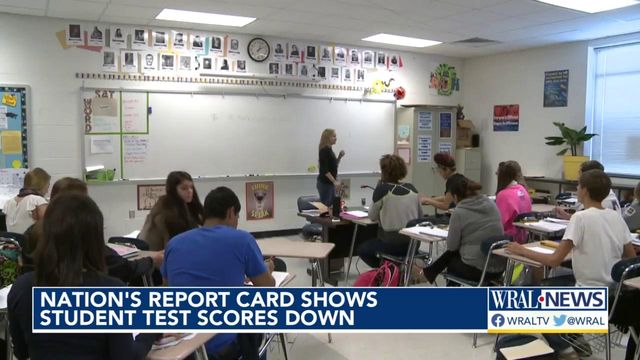NC, nation see significant drops in 4th- and 8th-grade reading and math
The 'Nation's Report Card' is the first state-to-state comparison since the pandemic began.
Posted — UpdatedThe drops in math scores are bigger than ever seen in the history of the National Assessment of Educational Progress, which is administered by the U.S. Department of Education. Scores on most tests in North Carolina and nationwide are the lowest they’ve been in at least 20 years, data show.
“If looking at these outcomes doesn’t make us want to double-down on system-wide academic recovery and use federal funds … [and] if this doesn’t fire you up to raise the bar on education, you’re in the wrong profession,” Cardona said.
The National Assessment of Educational Progress is a test that’s been administered in some form since 1990. Only samples of students take them — not all fourth- and eighth-grade students — so only state-level results are generally available. Some major cities — including Charlotte-Mecklenberg School and Guilford County Schools in North Carolina — agree to be sampled for a separate comparison of urban school systems. The U.S. Department of Education analyzes student populations in selecting representative samples of students to test, according to Grady Wilburn, a statistician and research scientist for the National Center for Education Statistics. This year, more than 450,000 students from 10,000 schools took one of the tests.
The results show a national struggle to maintain academic progress two years after schools first closed their doors to in-person instruction at the onset of the COVID-19 pandemic.
Scores in North Carolina and nationwide dropped by statistically significant amounts across all four tests administered since the last NAEP exam in 2019: fourth-grade reading, eighth-grade reading, fourth-gradeeighth-ath and 8th grade math. Scores in fourth-grade math, eighth-grade math and eighth-grade reading are the lowest they’ve been since test-taking procedures last changed in 2002 and 2003. In fourth-grade reading, scores in North Carolina are about as low as they were in 2005.
North Carolina schools remain on par with national performance. Its scores are comparable to neighboring states’ scores across most tests, with differences likely falling within the margin of error of one another. However, in eighth-grade math, Virginia scores measurably higher and South Carolina scores measurably lower. In eighth-grade reading, both Virginia and Georgia score measurably higher.
A change in average scores is statistically significant when it’s greater than the margin of error, Wilburn said.
What’s next
Three federal pandemic relief packages have provided billions of dollars for schools to use through 2024. At least 20% of the funds from the third stimulus package — the largest package, of which North Carolina received $3.6 billion — must go toward efforts to make up for lost time learning during pandemic-caused disruptions.
“We’re seeing a lot of districts spend and set aside even more,” said Roberto Rodriguez, U.S. Department of Education assistant secretary for planning, evaluation and policy development. “This is the moment for us to go all in.”
The U.S. Department of Education will not call on school systems to use more than 20% but expects them to spend more than that, Rodriguez said.
“We have to do more and we have to spend more,” Rodriguez said, noting the federal education department will promote practices for learning recovery supported by research.
Some outliers
The scores weren’t entirely bad news. In reading, urban school districts, which participate voluntarily, have largely showed statistically insignificant changes in scores since 2019.
That means urban districts had some success, compared to the national average, in teaching reading since 2019, said Peggy Carr, commissioner of the National Center for Educational Statistics. In recent years, the gap between urban districts and the national average has been closing because of bigger gains in the urban districts, she said.
“The fact that cities were able to hold steady in the wake of all that we went through, does strike me as resilience as a as a bright spot,” Carr said.
Those bright spots weren’t reflected in the two North Carolina school systems that participate in the urban district study. All test scores dropped significantly for Charlotte-Mecklenberg Schools and Guilford County Schools, with the only exception of eighth-grade reading for CMS. There, scores dropped by four points but were within the margin of error.
Fourth-grade math scores in Charlotte-Mecklenberg Schools dropped by several points more than in Guilford County Schools, though drops were similar on the other three tests. Scores in Charlotte-Mecklenberg Schools remain on par with or above scores nationwide, while scores in Guilford County Schools remain below scores nationwide.
What the scores don’t say
Experts caution extrapolating too much from the new data. The data can show decreases or increases in average scores, but how decreases or increases compare to one another requires more statistical analysis.
For example, North Carolina’s average scores dropped by more points than the nation’s scores on three our of the four tests. But U.S. Department of Education officials said that doesn’t mean North Carolina actually saw bigger drops than the nation, because the differences between the state’s drops and the nation’s drops may be within the margin of error.
The test scores also can’t be compared across grade levels — for instance, fourth-grade reading to eighth-grade reading — because each test is scored on a different scale according to its test-takers, Wilburn said.
Further, the test scores are measurements only of how well students did and don’t show why students did that well. Remote learning may have negatively impacted some test scores, but data don’t show remote learning could have been the only factor, Carr said.
Martin West, academic dean and professor of education at Harvard University’s Graduate School of Education, said it’s safe to say remote learning contributed to academic struggles, because other research has used other test score data to determine that. But the changes in NAEP data likely reflect more than just remote learning.
West, who spoke with Education Writers Association members during a webinar prior to the scores’ release, is also a member of the National Assessment Governing Board, which sets the rules for the NAEP.
Wilburn said others factors, such as stress related to losing a loved one or other pandemic disruptions, could cause worse academic outcomes as well.
Related Topics
• Credits
Copyright 2024 by Capitol Broadcasting Company. All rights reserved. This material may not be published, broadcast, rewritten or redistributed.






